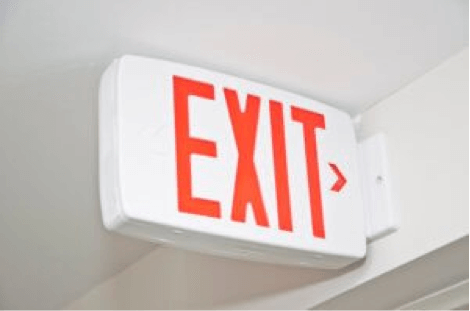The Importance of Visual Cues for Safe Evacuation

There’s a reason why exit signs are displayed in bright colors and in predictable locations. Whether the people inside a building are regular employees or first-time visitors, knowing how to safely exit a building is the most critical aspect of safe evacuation during a crisis.
Signs proscribing the use of elevators during an emergency are equally important, since power and mechanical failures are possible due to any number of causes. Having clear signage is critical because rational thinking and problem solving are often the first casualties when the threat of a natural disaster, terrorist attack, fire, or other emergency becomes imminent. Those well-placed signs save lives.
Under the Americans with Disabilities Act and OSHA safety guidelines, employers must provide accommodations to employees with disabilities, and provide accessibility in public buildings. In the cases of employees, clientele, or students who use wheelchairs, this includes providing access ramps; but it should also include a plan for safely evacuating a multi-story building when elevators are not in use. Whether you operate a hotel, shopping mall, arena, or office building–you need visual cues and signage to instruct your people in safe evacuation procedures for those who cannot use emergency stairways. Not only is this simply the right thing to do, it can also save you the expense of costly litigation should you ever experience a life-threatening emergency in your venue.
Does your building provide life-saving devices?
The simple fact is that many businesses’ plans for evacuating a wheelchair-bound individual is simply calling on emergency responders. Some may even have evacuation chairs somewhere in their facilities that allow non-ambulatory to be lowered down stairs. Thanks to the Slyde, however, there is a faster, safer, and more visible solution.
The Slyde is a medical sled that allows two to seven individuals to safely transport a disabled individual down multiple flights of stairs. It is lightweight, easy to operate, and, most importantly, can be publicly stored in an accessible area where it will be seen.
Look at the success of public-access defibrillators. It’s been determined that public-access defibrillators can double a person’s chance of surviving a cardiac arrest. Simply having defibrillators around in public spaces like malls and airports (accompanied by instructive signage) puts them on our radar and lets us know they are there for use in a medical emergency. They empower individuals to take active steps to help others. It is estimated that only 20 percent of heart attacks occur in public spaces, but among those, 95 percent of victims die before they reach a hospital.* Having defibrillators available improves their chances of survival.
The Slyde can also be viewed as a life-saving device. Should a fire or structural collapse put your constituents or clientele in danger, getting disabled individuals to safety can indeed save their lives. When elevators are not operating and everyone else is evacuating by stairs, you don’t want any individual to be left behind. Having a highly visible transport device at the ready can empower bystanders to take life-saving action.
Like defibrillators, the Slyde can be mounted easily in hallways and near staircases and elevators without obstructing traffic. A slim, mountable sleeve is available for purchase with the Slyde and can hold up to five devices more compactly than an evacuation chair. It also comes with a rope belay system that can be used to safely lower recumbent individuals down stairs. Add your own signage, train your staff, and you will have added another life-saving device to your evacuation plan.
Not only is the Slyde there for your people in an emergency, it also promotes public awareness of evacuation procedures. It is a powerful visual signal that you have a process and tools in place to evacuate disabled individuals.
To learn more about the Slyde, visit www.evacuationslyde.com or call us directly at 800-355-4628.
